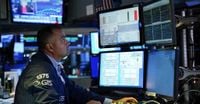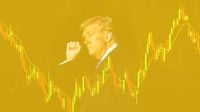On April 2, 2025, India’s benchmark stock indices, the Sensex and Nifty50, experienced a significant uptick, closing 593 points higher and surpassing the 23,300 mark, respectively. This surge came as investors reacted to the anticipated announcement of new tariffs by U.S. President Donald Trump, which are set to reshape international trade dynamics.
The market rally was primarily driven by gains in the IT and banking sectors, as investors positioned themselves ahead of Trump’s unveiling of reciprocal tariffs aimed at countries with trade deficits with the U.S. The announcement, dubbed "Liberation Day," is expected to have far-reaching implications for global trade norms.
As the U.S. prepares to impose a 25% tariff on auto imports effective April 3, 2025, and a universal tariff of 10% on all imports starting April 5, market participants are bracing for potential volatility. The White House has indicated that tariffs will vary by country, with India facing a 26% reciprocal tariff. This has raised concerns among investors about the potential impact on various sectors, particularly those reliant on exports.
Asian markets reacted cautiously to the news, with declines observed across the board. The S&P 500 futures fell over 3.5%, while the Nasdaq futures dropped 4.5%. The volatility index (VIX), which measures market expectations of near-term volatility, also saw fluctuations, indicating heightened investor anxiety.
In the Indian market, Tata Consumer Products shares soared by 8% following an upgrade to 'Buy' by Goldman Sachs, which raised its target price to Rs 1,200. Conversely, shares of RITES plummeted by 3% after the mutual agreement to foreclose a contract with UPSBCL.
Meanwhile, Tesla reported a disappointing first quarter, with deliveries slumping to 336,681 vehicles, significantly below the expected 372,410. This led to a 6% drop in Tesla’s shares, highlighting the company's ongoing challenges amid shifting consumer demand.
On the regulatory front, the Securities and Exchange Board of India (Sebi) announced new guidelines allowing investment advisers and research analysts to charge advance fees for up to a year, provided these fees do not exceed a year’s worth of services.
As the markets digested the implications of Trump’s tariff agenda, investors were also keeping an eye on the commodities market. Gold prices remained stable at Rs 94,150 per 10 grams, while silver saw a decline of Rs 1,000 to Rs 101,500 per kg.
Robert Kiyosaki, the well-known investor, predicted that silver prices could double in 2025, forecasting a rise to at least $70 an ounce. Kiyosaki emphasized silver's accessibility for a broad range of investors, suggesting it as a viable investment option amid market uncertainty.
In the broader landscape, Indian companies raised a record Rs 19.96 lakh crore in FY25, driven by robust participation in both equity and debt markets. This fundraising boom was bolstered by a surge in initial public offerings (IPOs), which doubled to Rs 3.71 lakh crore.
However, not all sectors are poised to benefit from the tariff changes. Analysts warn that the Indian stock market might be more vulnerable to U.S. economic shocks than direct tariffs. Samir Arora noted that the recent sell-off in Indian equities, particularly in the IT and banking sectors, reflects this concern.
As the market opened on April 3, 2025, the Indian rupee weakened to 85.78 against the U.S. dollar, a decline attributed to the looming tariff announcements. Forex traders indicated that the rupee's depreciation was a response to the heightened uncertainty in the markets.
In a sectoral analysis, the Global Trade Research Initiative (GTRI) highlighted that essential items such as pharmaceuticals and semiconductors would be exempt from the new tariffs, presenting an opportunity for India to bolster its position in global supply chains. Ajay Srivastava of GTRI pointed out that if India enhances its ease of doing business and invests in logistics, it could emerge as a significant global manufacturing hub.
Despite the challenges posed by the tariffs, agricultural economist Ashok Gulati expressed optimism about India's farm exports, suggesting that they may withstand the new duties better than those of competing nations, which face steeper tariffs.
As the dust settles on Trump’s tariff announcements, the focus shifts to how various sectors will adapt to the new trade landscape. The automotive and technology sectors appear particularly vulnerable, while pharmaceuticals and agriculture may find themselves in a relatively advantageous position.
In summary, the unfolding trade scenario presents a mixed bag for investors and businesses alike. While some sectors may face immediate challenges, others could leverage the situation to enhance their competitiveness. The next few weeks will be crucial as markets adjust to the new realities of international trade.









